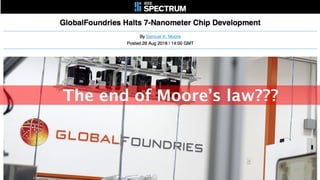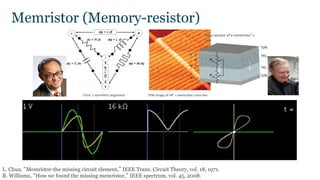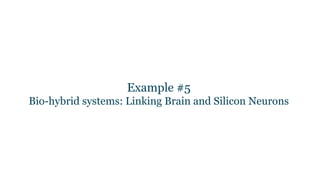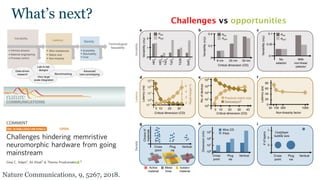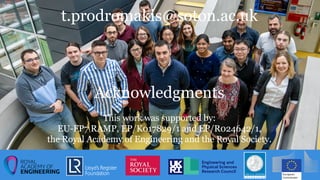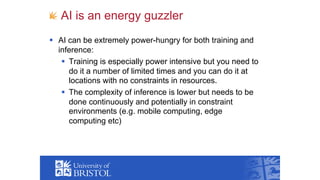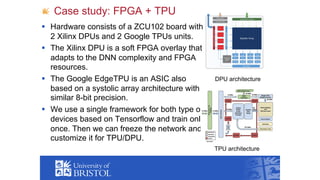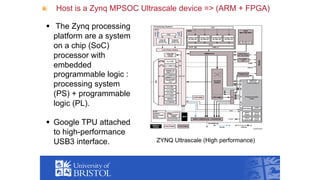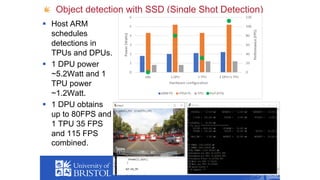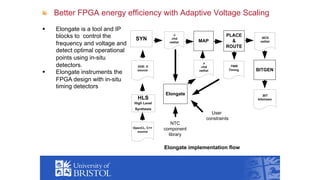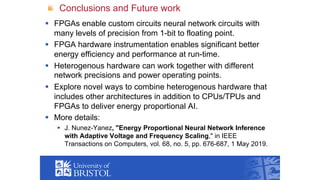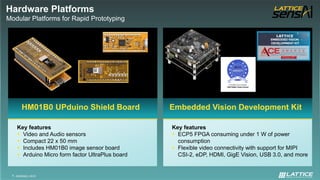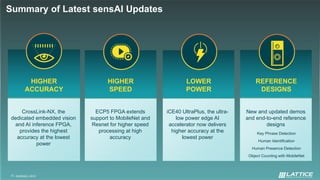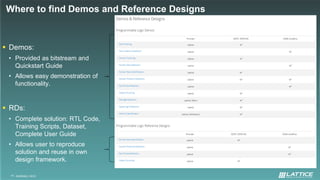Implementing AI: Hardware Challenges
- 2. • Knowledge Transfer Network (KTN) is Innovate UK’s Network partner • Innovate UK drive productivity and economic growth by supporting businesses to develop and realise the potential of new ideas, including those from the UK’s world-class research base. • Connecting with Knowledge Transfer Network can “lead to potential collaborations, horizon-expanding events, bespoke support and innovation insights relevant to your needs.” • Nigel Rix, Head of Enabling Technology: [email protected]
- 3. eFutures aims to strengthen and support a network of people working in electronic systems across the UK • Building new links and increasing involvement with industry • Mapping the national electronics research, to ensure the work across the UK is known and noted • Encouraging and funding innovative multi-disciplinary/multi-university proposals • Communicating with our network via a monthly magazine, social media and new website • Running events that support our network and our strategy • Piloting an academic Mentoring Scheme pilot • Launching a Big Ideas Challenge – more details soon • Ideas warmly welcomed. Please get involved! Twitter @efuturesuk Sign up to our mailing list: [email protected]
- 4. Agenda 10:15 - Professor Themis Prodromakis, Director of the Centre for Electronics Frontiers at the University of Southampton & founder of SoneT.ai 10:35 - Iain Wallace, Rovco 10:55 - Dr Jose Nunez Yanez, Reader in adaptive and energy efficient computing, University of Bristol 11.15 - Matt Holdsworth, Lattice SemiConductor 11:35 - 12:00 Panel Q&A, hosted by Professor Roger Woods, Queen’s University Belfast & CTO Analytics Engines BREAK 14:00- 15:00 Workshop 15:30 - 16:30 1-to-1 Meetings via meeting Mojo
- 5. Memristive Technologies from functional oxides to AI on a chip Themis Prodromakis Professor of Nanotechnology Zepler Institute, University of Southampton
- 6. Zepler Institute for Photonics & Nanoelectronics
- 7. Outline Modern electronics challenges & the AI era needs Memristors: • Technology • Tools & Infrastructure Application Examples – beyond memory Conclusion
- 8. Our AI is as good as our access to data ENGINEERING CHALLENGE: “The fundamental design of separate memory and processing places a limit on what can be achieved.”
- 9. Can we continue scaling? The end of Moore’s law???
- 11. Chua’s symmetry argument STM image of HP’s memristor cross-bar Cross-section of a memristor’s core. L. Chua, “Memristor-the missing circuit element,” IEEE Trans. Circuit Theory, vol. 18, 1971. R. Williams, “How we found the missing memristor,” IEEE spectrum, vol. 45, 2008. Memristor (Memory-resistor)
- 12. E-Beam lithography of Sub 15 nm ultrahigh density cross-bar memory chips Memristors fabrication Scientific Reports, 6, 32614, 2016. 12
- 13. Metal-oxide memristors memory capacity up to 7-bit states per cell 13 Scientific Reports, 7, 17532, 2017. b)a) Resistance(k) 30 50 70 90 0 5010 4020 30 Resistance(k) 80 Time (hrs) 2 3 4 50 1 60 40 30 70 50 Time (ms) S1 S47 b) c) Cumulativedistributionfunction(%) Resistance (k 30 0 20 80 60 40 100 40 50 60 Resistance(k) 6 80 Time (hrs) 2 3 4 50 871 60 40 30 S1 S47 S5 S7 70 50 S1 Memristors as analogue memory
- 14. Application Demonstrators Examples – beyond memory
- 15. Example #1 In-silico ML implementations
- 16. Scientific Reports, 6, 18639, 2016. Eric Kandel Nobel Prize in Physiology 2000 Emulating synapses with memristors
- 17. 17 Unsupervised learning in probabilistic memristor neural network Switching vs. resistive state relation at fixed voltage levels -> Exploit to encode conditional probabilities Desired switching level Approx. operating V Unsupervised Learning Nature Communications, 7, 12611, 2016.
- 18. 18 • Network shows capability of learning in unsupervised manner and handles mistakes rather well. • Copes with cases where class centres drift over time. Unsupervised learning in probabilistic memristor neural network Unsupervised Learning Nature Communications, 7, 12611, 2016.
- 19. 19 Unsupervised learning in probabilistic memristor neural network Unsupervised Learning • Whilst ‘learn once’ systems have their uses, ideally one wants something more flexible (e.g. if class centres drift over time). Nature Communications, 7, 12611, 2016.
- 20. Example #2 Energy-efficient Bayesian Inference
- 21. 21 Bayesian Inference “Hardware-Level Bayesian Inference”, Neural Information Processing Systems (NIPS), 2017. Computing directly in the probability domain Vector-Matrix-Vector Scalar multiply
- 22. Example #3 Empowering new design paradigms
- 23. Our world is analogue! Our electronics is mainly digital!
- 24. 24 Fusing Analogue and Digital Paradigms Charge-based computing Nature Communications, 9, 2170, 2018.
- 25. 25 Fusing Analogue and Digital Paradigms Charge-based computing Nature Communications, 9, 2170, 2018.
- 26. 26 In silico classifiers Charge-based computing Nature Communications, 9, 2170, 2018.
- 27. 27 In silico classifiers Charge-based computing Nature Communications, 9, 2170, 2018.
- 28. Example #4 Employ device physics for sensory data compression
- 29. On-node processing of rich data with single nanoscale devices 29 Memristive Sensors Nature Communications, 7, 12805, 2016.
- 30. Memristive Sensors Spike detection & sorting with single nanoscale devices Nature Communications, vol. 7, 12805, 2016. RSC Faraday Discussions, 213, 511-520, 2019.
- 31. 31 Memristive Sensors Spike sorting with single nanoscale devices Nature Communications, vol. 7, 12805, 2016. RSC Faraday Discussions, 213, 511-520, 2019.
- 32. Example #5 Bio-hybrid systems: Linking Brain and Silicon Neurons
- 33. “Memristive synapses connect brain and silicon spiking neurons”, Sc. Reports, 10, 2590, 2020 A geographically distributed bio-hybrid neural network Internet of Neuroelectronics ANPREBNABm
- 34. What’s next?
- 35. Unique solutions that address technology gaps across 4 computational pillars Thinking AI on a chip Our chipsets will equip AI systems with sensing, recognition, learning and reasoning capabilities, paving the way towards “Thinking Machines”. “AI on chips” will embed intelligence everywhere
- 36. How could the future look like?
- 37. A pathway to keep your data private!
- 38. Bioelectronic Medicines Feynman: “What I cannot create, I do not understand” Can we replace parts of our brain? Can we extend our brain’s capacity? Can we…??? Augmented Intelligence
- 39. What’s next? Nature Communications, 9, 5267, 2018. Challenges vs opportunities
- 40. 180nm TSMC node: - Custom design kit - Primitive cells (symbol, layout, extracted, Verilog-A) - HV infrastructure - Memory array design Under development: - Shared design library (IP, analogue cells, etc) - Scalable on-chip instrumentation 40 Monolithic integration on CMOS Top level reticle: Overall size: 10.9mm x 13.8mm
- 41. [email protected] Acknowledgments This work was supported by: EU-FP7 RAMP, EP/K017829/1 and EP/R024642/1, the Royal Academy of Engineering and the Royal Society.
- 43. Heterogeneous and adaptive computing for energy efficient AI Jose Nunez-Yanez University of Bristol/Royal Society industrial fellow
- 44. Talk structure § The energy and performance challenge in AI. § Addressing this challenge with custom hardware. § Optimizing energy and performance with adaptive voltage scaling and heterogenous circuits. § Conclusions and future work.
- 45. AI is an energy guzzler § AI can be extremely power-hungry for both training and inference: § Training is especially power intensive but you need to do it a number of limited times and you can do it at locations with no constraints in resources. § The complexity of inference is lower but needs to be done continuously and potentially in constraint environments (e.g. mobile computing, edge computing etc)
- 46. AI hardware accelerators available § Hardware accelerators deliver high-throughput, energy- efficiency and low-latency with power profiles ranging from watts (e.g. Google TPU, Intel NCS, Intel/Xilinx FPGAs, Graphcore ) to milliwatts with embedded processors based on ARM/RISCV with parallel (e.g. RISCV GAP) or subthreshold voltage computing (e.g. ETA/Ambiq) § Challenge: how to combine and deploy these different architectures to obtain optimal operating points for energy efficiency and performance.
- 47. Case study: FPGA + TPU § Hardware consists of a ZCU102 board with 2 Xilinx DPUs and 2 Google TPUs units. § The Xilinx DPU is a soft FPGA overlay that adapts to the DNN complexity and FPGA resources. § The Google EdgeTPU is an ASIC also based on a systolic array architecture with similar 8-bit precision. § We use a single framework for both type of devices based on Tensorflow and train only once. Then we can freeze the network and customize it for TPU/DPU. DPU architecture TPU architecture
- 48. Host is a Zynq MPSOC Ultrascale device => (ARM + FPGA) § The Zynq processing platform are a system on a chip (SoC) processor with embedded programmable logic : processing system (PS) + programmable logic (PL). § Google TPU attached to high-performance USB3 interface. ZYNQ Ultrascale (High performance)
- 49. Object detection with SSD (Single Shot Detection) § Host ARM schedules detections in TPUs and DPUs. § 1 DPU power ~5.2Watt and 1 TPU power ~1.2Watt. § 1 DPU obtains up to 80FPS and 1 TPU 35 FPS and 115 FPS combined.
- 50. Power Subsystem in ZCU102 board enables voltage scaling investigation I2C A series of PMBus commands are required to set the output voltage. Open-Standard Digital Power Management
- 51. Better FPGA energy efficiency with Adaptive Voltage Scaling § Elongate is a tool and IP blocks to control the frequency and voltage and detect optimal operational points using in-situ detectors. § Elongate instruments the FPGA design with in-situ timing detectors Elongate implementation flow MAP PLACE & ROUTE BITGEN .v .vhd netlist .NCD netlist .BIT bitstream .TWR Timing Elongate User constraints .v .vhd netlist .VHD .V source NTC component library SYN HLS High Level Synthesis OpenCL, C++ source
- 52. Example of timing detector for logic § Soft-macro detectors create different paths for the slow flip-flop (SFF) and the main flip-flop (MFF). § Discrepancies between MFF and SFF are detector in XOR. § MFF replicates the functionality of the original flip-flop in the critical path. Generate 0 Generate 1 XOR SFF MFF Q Output Detector Output D Input 0/1 0/1 Data Steering MUXF8 MUXF5 Synchronizer FF
- 53. AI architecture with voltage and frequency scalability ARM A53 MP ELO CONTROL FREQ/PHASE BNN_ZU0 ELO_CLK ELO_CLK_ PHASE I2C Voltage regulators AXI slave (128b) Reset elo freq Reset elo phase Peripheral and PMBUS interfaces AXI interconnect BNN_ZU1 BNN_ZU2 BNN_ZU3Enable Detector error LEDS (Locked, error, debug) Master HPM1 (128b) Slave HP0 (128b) Slave HP1 (128b) Slave HP2 (128b) Slave HP3 (128b) DMA0 DMA1 DMA2 DMA3 AXI master (128b) Power rail voltage regulators AXI master (128b) AXI slave (128b) AXI master (128b) AXI slave (128b) AXI master (128b) AXI slave (128b) VCCINT AXI interconnect CCI (cache coherent interface) Master HPM0 (128b) § Only one FPGA core is instrument ed with Elongate detectors. § All cores use the same voltage and frequency.
- 54. Elongate complexity overheads (LUTs and FFs) 0 1 2 3 4 5 6 7 8 9 10 11 12 13 14 0 2 4 6 8 10 12 14 overhead% path timing % FF ZY LUTS ZY FF ZU LUTS ZU
- 55. Power scalability in Zynq ultrascale § Voltage levels range from 0.55 v to 0.85 v for the 16nm Zynq Ultrascale device. § Elastic power/perform ance with up to 85% power reduction or 2x performance.
- 56. Adaptive Voltage Scaling Applied to convolutional neural network 380.95, 78.5 352.38, 78.4292.59, 78.4180.95, 78.3 0 10 20 30 40 50 60 70 80 90 170 190 210 230 250 270 290 310 330 350 370 390 410 Accuracy% Frequency(MHz) run_0.85v run_0.75v run_0.65v run_0.55v
- 57. Conclusions and Future work § FPGAs enable custom circuits neural network circuits with many levels of precision from 1-bit to floating point. § FPGA hardware instrumentation enables significant better energy efficiency and performance at run-time. § Heterogenous hardware can work together with different network precisions and power operating points. § Explore novel ways to combine heterogenous hardware that includes other architectures in addition to CPUs/TPUs and FPGAs to deliver energy proportional AI. § More details: § J. Nunez-Yanez, "Energy Proportional Neural Network Inference with Adaptive Voltage and Frequency Scaling," in IEEE Transactions on Computers, vol. 68, no. 5, pp. 676-687, 1 May 2019.
- 58. Acknowledgement • Thanks to the Royal Society with the MINET industrial fellow award and Xilinx for the hardware/software support.
- 60. LATTICE RISING 2020 Delivering Milliwatt AI to the Edge with Ultra-Low Power FPGAs Matt Holdsworth FAE Lattice Semiconductors [email protected]
- 61. - NASDAQ: LSCC2 Rapidly Emerging Edge Computing Trend Edge Networking Cloud IoT Communication Gateway Wireless / Wireline Access Core Network Driven by Latency, Privacy, and Bandwidth Limitations Unit growth for edge devices with AI will explode increasing over 110% CAGR over the next five years – Semico Research
- 62. - NASDAQ: LSCC3 HARDWARE PLATFORMS IP CORES SOFTWARE TOOLS REFERENCE DESIGNS / DEMOS CNN Compact Accelerator CNN Accelerator UPduino + Himax Shield – iCE40 UltraPlus FPGA Embedded Vision Development Kit – ECP5 FPGA 1 mW, 5.5 mm2, 1/8/16 bits 1 W, 100 mm2, 1/8/16 bits CUSTOM DESIGN SERVICES Smart CarSmart Home Smart City Smart Factory Neural Network Compiler Ultra Low Power Small Form Factor Customizable Neural Network Accelerators Key Phrase Detection Object Counting Object Identification Human Presence Detection Face Tracking Hand Gesture Detection
- 63. - NASDAQ: LSCC4 Focus Applications Focus Applications Object Detection Human Machine Interface (HMI) Object Identification Defect detection in smart security and embedded vision cameras Feature extraction enabling navigation of robots Key Phrase detection to control smart appliances
- 64. - NASDAQ: LSCC5 Reference Design / Demo – Human Presence Detection FEATURES Sensor CMOS image sensor Speed 5 frames per second Power 7 mW on iCE40 UltraPlus ALWAYS ON HUMAN DETECTION IN APPLIANCE LOW POWER HUMAN DETECTION FOR WAKE ON APPROACH FOR LAPTOPS AND PRINTERS
- 65. - NASDAQ: LSCC6 Reference Design / Demo Object Counting FEATURES Sensor CMOS image sensor Speed 17 frames per second - Lower Latency Power 850 mW on ECP5-85K HUMAN DETECTION IN VIDEO SECURITY DEVICES HUMAN COUNTING IN RETAIL CAMERA APPLICATIONS DEFECT DETECTION AND OPERATOR COMPLIANCE IN SMART FACTORY CAMERAS Defect Detected Type: Crack
- 66. - NASDAQ: LSCC7 Popular sensAI Accelerator Use Cases Post Processing Preprocessing PreprocessingStand-alone
- 67. - NASDAQ: LSCC8 Hardware Platforms Modular Platforms for Rapid Prototyping Key features ▪ Video and Audio sensors ▪ Compact 22 x 50 mm ▪ Includes HM01B0 image sensor board ▪ Arduino Micro form factor UltraPlus board HM01B0 UPduino Shield Board Key features ▪ Video and Audio sensors ▪ Compact 22 x 50 mm ▪ Includes HM01B0 image sensor board ▪ Arduino Micro form factor UltraPlus board Key features ▪ Video and Audio sensors ▪ Compact 22 x 50 mm ▪ Includes HM01B0 image sensor board ▪ Arduino Micro form factor UltraPlus board Embedded Vision Development Kit Key features ▪ ECP5 FPGA consuming under 1 W of power consumption ▪ Flexible video connectivity with support for MIPI CSI-2, eDP, HDMI, GigE Vision, USB 3.0, and more
- 68. - NASDAQ: LSCC9 Software Tools Neural Network Compiler ▪ Implement networks developed using standard frameworks into Lattice FPGAs without prior RTL experience ▪ Rapidly analyze, simulate, and compile CNNs/BNNs for implementation on Lattice sensAI IP cores Key Features
- 69. - NASDAQ: LSCC10 Customizable Reference Designs Trained Model Quantized Weights and Instructions FPGA Bitstream Training FPGA Design NN Models NN IP System Interface Training Dataset Training Scripts NN Compiler Lattice sensAI Components Lattice FPGA Design Tools ML Frameworks
- 70. - NASDAQ: LSCC11 PERFORMANCE POWER 1 fps 5 fps MCU 2W 400mW SoC 5x FASTER 5x LOWER Sensors MCU Results Lattice CrossLink-NX SRAM (weights / activations) Sensor Interface Neural Network Accelerators ALWAYS-ON HUMAN COUNTING Higher Performance and Lower Power with CrossLink-NX ECP5-45K NX-40K 10 fps 2x FASTER ECP5-45K 200mW NX-40K2x LOWER
- 71. - NASDAQ: LSCC12 HIGHER ACCURACY REFERENCE DESIGNS HIGHER SPEED LOWER POWER Summary of Latest sensAI Updates CrossLink-NX, the dedicated embedded vision and AI inference FPGA, provides the highest accuracy at the lowest power ECP5 FPGA extends support to MobileNet and Resnet for higher speed processing at high accuracy iCE40 UltraPlus, the ultra- low power edge AI accelerator now delivers higher accuracy at the lowest power New and updated demos and end-to-end reference designs Key Phrase Detection Human Identification Human Presence Detection Object Counting with MobileNet
- 72. - NASDAQ: LSCC13 Reference Design ▪Where to find sensAI page • Applications -> AI/Machine Learning
- 73. - NASDAQ: LSCC14 Where to find Demos and Reference Designs ▪ Demos: • Provided as bitstream and Quickstart Guide • Allows easy demonstration of functionality. ▪ RDs: • Complete solution: RTL Code, Training Scripts, Dataset, Complete User Guide • Allows user to reproduce solution and reuse in own design framework.
- 74. - NASDAQ: LSCC15 HARDWARE PLATFORMS IP CORES SOFTWARE TOOLS REFERENCE DESIGNS / DEMOS CNN Compact Accelerator CNN Accelerator UPduino + Himax Shield – iCE40 UltraPlus FPGA Embedded Vision Development Kit – ECP5 FPGA 1 mW, 5.5 mm2, 1/8/16 bits 1 W, 100 mm2, 1/8/16 bits CUSTOM DESIGN SERVICES Smart CarSmart Home Smart City Smart Factory Neural Network Compiler Ultra Low Power Small Form Factor Customizable Neural Network Accelerators Key Phrase Detection Object Counting Object Identification Human Presence Detection Face Tracking Hand Gesture Detection









